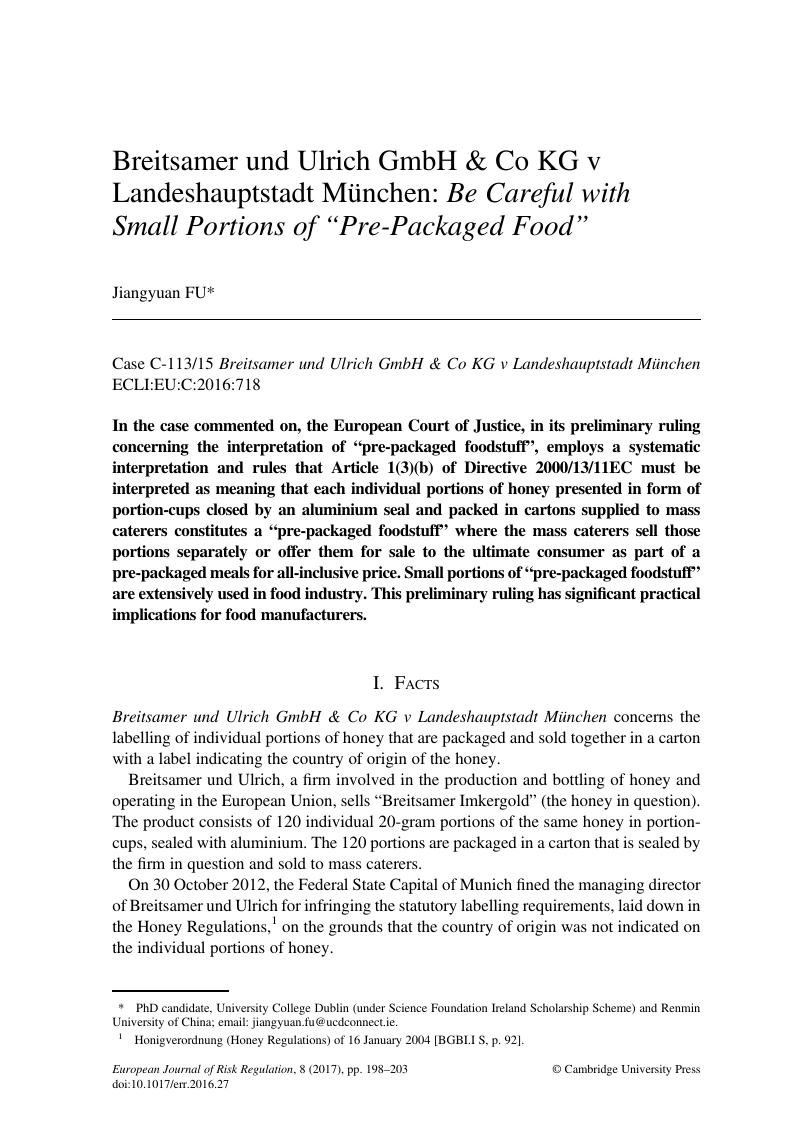No CrossRef data available.
Article contents
Breitsamer und Ulrich GmbH & Co KG v Landeshauptstadt München: Be Careful with Small Portions of “Pre-Packaged Food”
Published online by Cambridge University Press: 26 April 2017
Abstract

- Type
- Case Commentaries
- Information
- European Journal of Risk Regulation , Volume 8 , Issue 1: Cambridge Inaugural Issue: The Past, Present And Future of Risk Regulation , March 2017 , pp. 198 - 203
- Copyright
- © Cambridge University Press
Footnotes
PhD candidate, University College Dublin (under Science Foundation Ireland Scholarship Scheme) and Renmin University of China; email: jiangyuan.fu@ucdconnect.ie.
References
1 Honigverordnung (Honey Regulations) of 16 January 2004 [BGBI.I S, p. 92].
2 Directive 2000/13/EC of the European Parliament and of the Council of 20 March 2000 on the approximation of laws of the Member States relating to the labelling, presentation and advertising of foodstuffs. OJ L109/36 [Foodstuffs Labelling Directive].
3 Regulation (EU) 1169/2011 of the European Parliament and of the Council of 25 October 2011 on the provision of food information to consumers, amending Regulations (EC) No 1924/2006 and (EC) No 1925/2006 of the European Parliament and of the Council, and repealing Commission Directive 87/250/EEC, Council Directive 90/496/EEC, Commission Directive 1999/10/EC, Directive 2000/13/EC of the European Parliament and of the Council, Commission Directives 2002/67/EC and 2008/5/EC and Commission Regulation (EC) No 608/2004, OJ L 304 (Foodstuffs Labelling Regulation).
4 Council Directive 2001/110/EC of 20 December 2001 relating to honey OJ L10 (Honey Directive).
5 Case C-113/15 Breitsamer und Ulrich GmbH & Co KG v Landeshauptstadt München ECLI:EU:C:2016:718, at para. 44.
6 Art. 13(1)(b) and Recital 15 Directive 2000/13/EC.
7 Art. 3 states that an “indication of the … particulars [listed items (1) to (10)] alone shall be compulsory on the labelling of foodstuffs”. Item (8) is worded as “particulars of the place of origin or provenance where failure to give such particulars might mislead the consumer to a material degree as to the true origin or provenance of the food stuff.”
8 Art. 4(2) states that EU provisions applicable to specific foodstuffs could require that other particulars, in addition to those listed in Art. 3, be given on the labelling. In the absence of such EU provisions, Member States nevertheless could themselves provide for such particulars to be shown in accordance with the procedure laid down in Art. 19.
9 Breitsamer, supra note 5, at para. 49.
10 Breitsamer, supra note 5, at para. 52.
11 Opinion of Advocate General Sharpston, delivered on 5 April 2016 in Case C-113/15 Breitsamer [2016] ECLI:EU:C:2016:200, at para. 58.
12 Working Group of Commission’s Health and Consumer Directorate General, Questions and Answers on the application of the Regulation (EU) No.1169/2011 on the provision of food information to consumers (2013), available at <https://ec.europa.eu/food/sites/food/files/safety/docs/labelling_legislation_qanda_application_reg1169-2011_en.pdf> (last accessed 19 December 2016), p. 3.
13 Ibid at p. 1.
14 Opinion of Advocate General Sharpston in Breitsamer, supra note 11, at para. 54.
15 Recital 6 of Directive 2000/13/EC.
16 Recital 8 of Directive 2000/13/EC.
17 Art. 2(a)(i) of Directive 2000/13/EC.
18 Breitsamer, supra note 5, at para. 71.
19 Ibid, at para. 54.
20 Ibid, at para. 82.
21 Giulio Itzcovich, “The Interpretation of Community Law by the European Court of Justice” (2009) 10(5) German Law Journal 537, 539.
22 Ibid, 538.
23 Joxerramon Bengoetxea and Neil MacCormick, “Integration and Integrity in the Legal Reasoning of the European Court of Justice” in Grainne de Burca and Joseph HH Weiler (eds), The European Court of Justice (Oxford University Press 2001) 43.
24 See the 1969 Vienna Convention on the law of Treaties. Done at Vienna on 23 May 1969. Entered into force on 27 January 1980. United Nations, Treaty Series, vol. 1155 at 331. Art. 31 states that, in accordance with a general rule of interpretation, a treaty shall “be interpreted in good faith in accordance with the ordinary meaning to be given to the terms of the treaty in their context and in the light of its object and purpose”.
25 Art. 14 of Directive 2000/13.
26 Case 283/81 CILFIT ECLI:EU:C:1982:335, at para. 18.
27 The European Union has 24 official languages. The Treaty on the Functioning of the European Union and the Treaty establishing the European Atomic Energy Community, [2012] OJ L112/15.
28 EEC Council: Regulation No 1 determining the languages to be used by the European Economic Community, [1958] OJ L 17/385, Arts. 4 and 5.
29 See Cases C-558/11, Kurcums Metal v Valsts ieņēmumu dienests ECLI:EU:C:2012:721, at para. 48; and C-112/15, Kødbranchens Fællesråd v Ministeriet for Fødevarer, Landbrug og Fiskeri and Fødevarestyrelsen ECLI:EU:C:2016:185, at para. 36.
30 Breitsamer, supra note 5, at para. 53.
31 Case C-315/05 Lidl Italia srl v Comune di Arcole (VR) [2006] ECLI:EU:C:2006:736; Case C-29/69 Erich Stauder v City of Ulm – Sozialamt ECLI:EU:C:1969:57.
32 Stauder, ibid, at para. 4.
33 Breitsamer, supra note 5, at para. 71.
34 Ibid, at para. 66.
35 Regulation 1169/2011 merges the previous legislation, Directives 2000/13/EC and 90/496/EEC on nutritional labelling, supra note 3.




